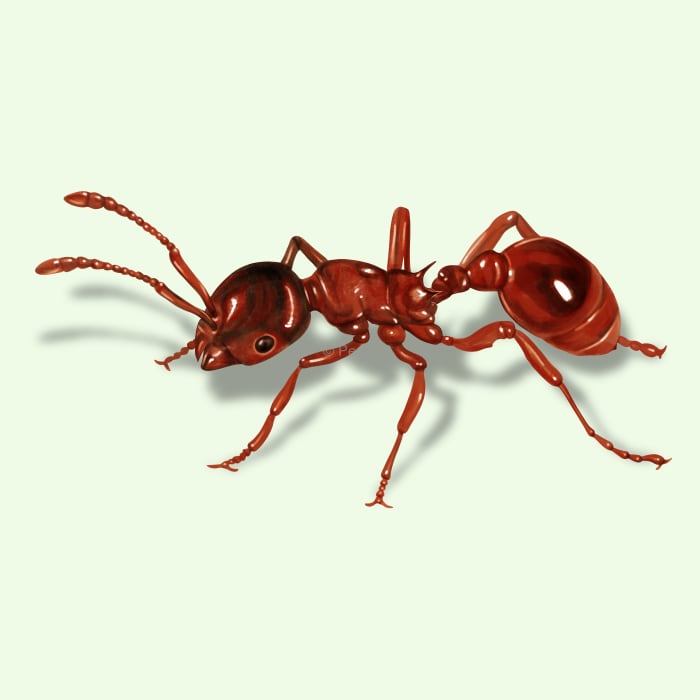How to identify and get rid of European fire ants

Fire in the hole: tips to extinguish European fire ants
Have you ever been working in your garden or sitting outside and felt a sharp sting on your hands, arms, or legs?
You might have had the misfortune of stumbling onto a European fire ant nest. These small but feisty ants are not just a nuisance; they can become a real issue for homeowners.
European fire ants are known for their aggressive behavior and painful stings. Homeowners often discover the presence of these ants too late, when colonies have fully established themselves in moist soil, under rocks, or amidst the mulch of garden beds.
Originating from Europe, European fire ants have found the right places in the moist environments of the northeastern United States, making them a perfect place to call home.
The European fire ant's life cycle includes several stages, beginning with the queen laying eggs that develop into larvae and then pupae before maturing into adults. Under the right conditions, these colonies can grow rapidly until the infestation is widespread. Managing their presence involves understanding their biology and behaviors, such as their preference for damp conditions and aggressive defense mechanisms, which are crucial for effective control measures.
How to identify European fire ants
European fire ants are small, ranging in color from bright red to dark brown. They have two nodes or lumps on their thin waist and two backward-pointing spines on their thorax.
The colonies can have up to 100 queens living together, producing multiple colony sites.
Unlike some other ant species that avoid human interaction, European fire ants are quite aggressive and will not hesitate to sting if they feel threatened. This can make yard work or relaxation in your garden a painful experience.
How big are European fire ants?
Workers are typically 1/6 to 1/5 inch in size.
What other pest looks like a European fire ant?
European fire ants may be mistaken for common red ants, but their aggressive behavior and preference for moist environments help you spot the difference.
Where do European fire ants live?
These ants are originally from Europe but have been accidentally introduced to the US. They are mostly found in the Northeastern States.
You can typically find them outdoors, nesting in moist areas such as under rocks, logs, or within mulch and leaf litter.
How to get rid of European fire ants
Getting rid of European fire ants can be tricky since they form satellite colonies that assist one another. However, eliminating their preferred habitats and food sources from your home and property can help reduce their numbers.
Here are a few tips for preventing European fire ants from taking over:
- Remove attraction: Eliminate standing water and keep the garden less moist. Mowing regularly can reduce moisture in your yard.
- Physical barriers: Use barriers like gravel or sand around garden beds to deter nesting.
- Ant bait stations: These ants like sweets, and using a sweet substance with a slow-acting pesticide can eliminate queens.
- Seal cracks and gaps: Seal any possible entry points around your home to keep scouting ants out.
- Clean up any food or sweets: Regularly cleaning your kitchen can prevent ants from exploring inside and looking for food.
Also, consider using an insect barrier spray in and around your home. Pestie offers a pro-grade solution that you can apply yourself. In just a few minutes, you can have a bug-free home, guaranteed.
Treat european fire ants with Pestie
If you're still having trouble keeping european fire ants away, the best option is to use a pro-grade, effective pest control solution like Pestie.
Pestie is a do-it-yourself pest control solution that's specially designed to keep european fire ants and other pests away from your home.
With Pestie, you can rest easy knowing that your living space is protected and free of creepy crawlies. And the best part? It's designed for people, pets, and the planet, so you can say goodbye to harsh chemicals and hello to peace of mind!
- Save hundreds compared to traditional annual pest plans
- People, pet, and planet-friendly
- Pro-grade customized formulas
Quick facts
How dangerous are European Fire Ants?
Medium danger risk
While not life-threatening, their stings can be painful and may cause allergic reactions in sensitive individuals.
- Scientific name
Myrmica rubra
- Other common names
European Fire Ants
- Colors
Reddish-brown
- Life span
Workers live for several months; queens can live up to 15 years
- Diet
Insects and sweets
European fire ants have an odd caste in their colonies. They have queens, workers, and male drones, but also micro queens that live among the larger ants and sometimes found their own colonies.








